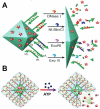Bioengineering of Metal-organic Frameworks for Nanomedicine
- PMID: 31244945
- PMCID: PMC6567971
- DOI: 10.7150/thno.31918
Bioengineering of Metal-organic Frameworks for Nanomedicine
Abstract
Controlled structure, tunable porosity, and readily chemical functionalizability make metal-organic frameworks (MOFs) a powerful biomedical tool. Nanoscale MOF particles have been increasingly studied as drug carriers, bioimaging agents, and therapeutic agents due to their excellent physiochemical properties. In this review, we start with MOF as a nanocarrier for drug delivery, covering therapeutic MOF agents followed by a comprehensive discussion of surface bioengineering of MOF for improved biostability, biocompatibility, and targeted delivery. Finally, we detail the challenges and prospects of the future of MOF research for biomedical applications.
Keywords: Metal-organic frameworks; drug delivery; photodynamic therapy; surface engineering.
Conflict of interest statement
Competing Interests: The authors have declared that no competing interest exists.
Figures





Similar articles
-
Metal-Organic Framework Nanoparticle-Based Biomineralization: A New Strategy toward Cancer Treatment.Theranostics. 2019 May 18;9(11):3134-3149. doi: 10.7150/thno.33539. eCollection 2019. Theranostics. 2019. PMID: 31244946 Free PMC article. Review.
-
Polyphenol-Based Particles for Theranostics.Theranostics. 2019 May 18;9(11):3170-3190. doi: 10.7150/thno.31847. eCollection 2019. Theranostics. 2019. PMID: 31244948 Free PMC article. Review.
-
Recent Developments of Supramolecular Metal-based Structures for Applications in Cancer Therapy and Imaging.Theranostics. 2019 May 18;9(11):3150-3169. doi: 10.7150/thno.31828. eCollection 2019. Theranostics. 2019. PMID: 31244947 Free PMC article. Review.
-
Theranostics of metal-organic frameworks: image-guided nanomedicine for clinical translation.Nanomedicine (Lond). 2023 Apr;18(8):695-703. doi: 10.2217/nnm-2022-0278. Epub 2023 Jun 1. Nanomedicine (Lond). 2023. PMID: 37259854 Review.
-
Recent Advances in Metal-Organic Frameworks as Anticancer Drug Delivery Systems: A Review.Anticancer Agents Med Chem. 2021;21(18):2487-2504. doi: 10.2174/1871520621666210119093844. Anticancer Agents Med Chem. 2021. PMID: 33463479 Review.
Cited by
-
Supramolecular Nanotheranostics.Theranostics. 2019 May 25;9(11):3014-3016. doi: 10.7150/thno.36788. eCollection 2019. Theranostics. 2019. PMID: 31244939 Free PMC article.
-
Recent Advances in Nanoscale Metal-Organic Frameworks Towards Cancer Cell Cytotoxicity: An Overview.J Inorg Organomet Polym Mater. 2021;31(7):2715-2756. doi: 10.1007/s10904-021-02011-3. Epub 2021 May 12. J Inorg Organomet Polym Mater. 2021. PMID: 33994899 Free PMC article. Review.
-
Biodegradable Metal Organic Frameworks for Multimodal Imaging and Targeting Theranostics.Biosensors (Basel). 2021 Aug 27;11(9):299. doi: 10.3390/bios11090299. Biosensors (Basel). 2021. PMID: 34562889 Free PMC article. Review.
-
Metal-Organic Frameworks: Synthetic Methods and Potential Applications.Materials (Basel). 2021 Jan 9;14(2):310. doi: 10.3390/ma14020310. Materials (Basel). 2021. PMID: 33435267 Free PMC article. Review.
-
Challenges and opportunities in delivering oral peptides and proteins.Expert Opin Drug Deliv. 2023 Jul-Dec;20(10):1349-1369. doi: 10.1080/17425247.2023.2237408. Epub 2023 Jul 17. Expert Opin Drug Deliv. 2023. PMID: 37450427 Free PMC article. Review.
References
-
- Guo Z, Xiao C, Maligal-Ganesh RV, Zhou L, Goh TW, Li X. et al. Pt nanoclusters confined within metal-organic framework cavities for chemoselective cinnamaldehyde hydrogenation. ACS Catal. 2014;4:1340–8.
-
- Li Z, Peters AW, Platero-Prats AE, Liu J, Kung C-W, Noh H. et al. Fine-Tuning the Activity of Metal-Organic Framework-Supported Cobalt Catalysts for the Oxidative Dehydrogenation of Propane. J Am Chem Soc. 2017;139:15251–8. - PubMed
-
- Zhao M, Yuan K, Wang Y, Li G, Guo J, Gu L. et al. Metal-organic frameworks as selectivity regulators for hydrogenation reactions. Nature. 2016;539:76. - PubMed
-
- Li P, Moon S-Y, Guelta MA, Lin L, Gómez-Gualdrón DA, Snurr RQ. et al. Nanosizing a metal-organic framework enzyme carrier for accelerating nerve agent hydrolysis. ACS Nano. 2016;10:9174–82. - PubMed
-
- Shi W, Zhao X, Feng J, Liu J, Yang G, Wang G. et al. An Efficient, Visible-Light-Driven, Hydrogen Evolution Catalyst NiS/ZnxCd1-xS Nanocrystal Derived from a Metal-Organic Framework. Angew Chem Int Ed Engl. 2018;57:9790–4. - PubMed
Publication types
MeSH terms
Substances
LinkOut - more resources
Full Text Sources
Other Literature Sources

